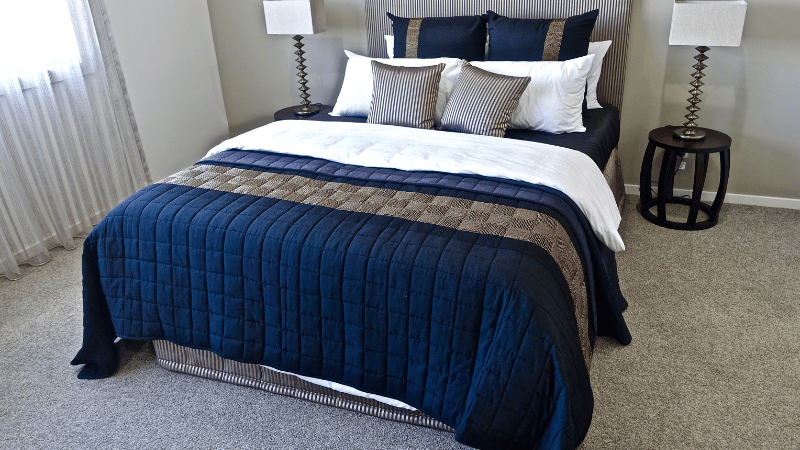Imagine a long day of exploring new places and all you want is a good night’s sleep in a comfortable, allergy-friendly bed. The importance of quality bedding goes beyond just aesthetics—it plays a crucial role in your guests’ comfort and overall well-being. Have you ever thought about what materials your mattress is made from or what chemicals can be lurking in it? When it comes to creating a restful stay, the choice of bedding can significantly impact how well your guests sleep and how they feel upon waking. Here’s why bedding choices matter and how to ensure they contribute to a restful and allergy-free environment.
The Impact of Bedding on Comfort and Well-Being
Bedding isn’t just about making a bed look inviting; it affects both physical comfort and health. Here’s why selecting the right bedding is essential:
Allergies and Sensitivities
Allergy sufferers and those with Multiple Chemical Sensitives can experience discomfort and disrupted sleep due to common allergens found in bedding. Dust mites, mold spores, pet dander, synthetic chemicals and certain fabrics can all contribute to allergic reactions or adverse health effects. Even the laundry detergent used to wash the sheets and pillowcases can affect their quality of sleep and deter someone from staying at a place. Choosing bedding materials that minimize these effects can help create a more comfortable and healthier sleeping environment for you and your guests.
Why Choose Non-Toxic Bedding
Given that we spend a significant portion of our lives in bed, the materials and chemicals present in our bedding and mattresses can have a substantial impact on our well-being. Many conventional mattresses and bedding contain synthetic materials and chemicals like flame retardants, formaldehyde and volatile organic compounds (VOCs). These substances can off-gas, releasing harmful fumes into the air, which you then inhale throughout the night. Non-toxic beds, made from natural and organic materials, are less likely to emit allergens or irritants that can trigger respiratory issues, asthma or allergic reactions. Some chemicals in conventional bedding, like phthalates and certain flame retardants, can act as endocrine disruptors, interfering with hormone function. Prolonged exposure to these can contribute to various health problems, including developmental issues, reproductive health concerns and even certain cancers. In addition, sleeping on materials treated with chemicals or synthetic dyes can lead to skin irritation, rashes, or other dermatological issues, particularly for those with sensitive skin.
Key Features of Non-Toxic Bedding
- Natural and Organic Materials
- Organic Cotton: Grown without the use of synthetic pesticides, herbicides, or genetically modified organisms (GMOs). Organic cotton bedding is soft, breathable, and hypoallergenic.
- Linen: Made from flax plants, linen is naturally resistant to bacteria, mildew, and moisture. It’s durable and becomes softer with each wash.
- Bamboo: Bamboo bedding is naturally hypoallergenic and resistant to dust mites and bacteria. It’s also moisture-wicking and temperature-regulating.
- Wool: Naturally flame-resistant, wool is often used in mattress toppers, blankets, and comforters. It’s breathable and helps regulate body temperature.
- Natural Latex: Made from the sap of rubber trees, natural latex is often used in mattresses and pillows. It’s hypoallergenic, durable, and resistant to dust mites and mold.
- Absence of Harmful Chemicals
- No Flame Retardants: Many conventional mattresses are treated with flame retardants that can off-gas harmful chemicals. Non-toxic bedding uses materials that naturally meet flammability standards without added chemicals.
- No VOCs (Volatile Organic Compounds): VOCs are emitted as gases from certain chemicals and can cause health issues. Non-toxic bedding avoids materials that release VOCs.
- No Formaldehyde: Some bedding and mattresses are treated with formaldehyde to prevent wrinkles or mildew. Non-toxic options are free from this carcinogenic chemical.
- No Phthalates: Commonly found in waterproof mattress covers and some synthetic materials, phthalates can disrupt hormones. Non-toxic bedding avoids these plasticizers.
- Certifications to Look For:
- GOTS (Global Organic Textile Standard): Ensures that textiles are truly organic and have been produced sustainably.
- OEKO-TEX Standard 100: Tests for harmful substances in textiles, ensuring that they are safe for human use.
- GreenGuard: Certifies products for low chemical emissions, contributing to healthier indoor air quality.
- Made Safe: Indicates that a product is made without toxic chemicals known to harm human health.
Benefits of Non-Toxic Bedding
- Healthier Sleep Environment: Reduces exposure to potentially harmful chemicals that can affect respiratory health, skin, and overall well-being.
- Eco-Friendly: Supports sustainable farming and manufacturing practices, reducing environmental impact.
- Allergy Relief: Non-toxic bedding often avoids common allergens like synthetic dyes and chemical finishes, making it suitable for people with sensitivities.
- Durability: High-quality natural materials often have a longer lifespan than synthetic alternatives, providing better value over time.
Tips for Choosing Non-Toxic Bedding Brand
If you search for non-toxic bedding, there are many suggestions that pop up including Savvy Rest, Naturepedic, Coyuchi, Boll and Branch and Avocado Green Mattress to name just a few. Whatever mattress brand you are reading up on, it is important to keep these tips in mind while shopping for a mattress.
- Check Certifications: Look for reliable certifications like GOTS, OEKO-TEX, and GreenGuard to ensure the bedding is truly non-toxic.
- Read Labels: Avoid products with vague terms like “natural” or “eco-friendly” without clear evidence or certification.
- Choose Natural Materials: Opt for bedding made from organic cotton, linen, wool, or bamboo.
- Avoid Synthetic Blends: Stay away from bedding that includes synthetic fibers like polyester, which can be treated with chemicals.
Practical Tips for Maintaining Allergy-Friendly Bedding
To ensure your bedding remains allergy-friendly and comfortable, follow these
practical tips:
Organic and Quality Sheets, Comforter and Pillowcases
Not only does the mattress matter but also the sheets, comforter and pillowcases on the mattress matter. Quality sheets can reduce a person’s sensitives and allergens. Organic sheets can also be quality, be free of synthetic chemicals and reduce adverse health effects.
Laundry Detergent
The laundry detergent that is used for washing the bedding materials is extremely important. Many people react to the chemicals found in laundry detergent, such as, fragrance and perfume. Choosing a laundry detergent that is free from harsh chemicals can decrease the amount of people having allergic reactions to the bedding you provide. There are many brands out there to choose from but here are some to get you started, Molly Suds, Branch Basics Laundry Detergent, Ecos Laundry Detergent or Seventh-Generation Free and Clear
Regular Cleaning
Frequent cleaning is essential for maintaining allergen-free bedding. Wash sheets, pillowcases, and mattress protectors at least once a week in hot water to remove dust mites and other potential allergens. Clean pillows and comforters according to the manufacturer’s instructions.
Vacuuming and Dusting
Regularly vacuuming carpets, rugs and upholstery can help reduce the buildup of allergens in your home. Dusting surfaces and cleaning air vents can also minimize the presence of dust and other irritants.
Humidity Control
Maintaining low humidity levels can help prevent mold growth and dust mites. Use dehumidifiers and ensure proper ventilation in areas prone to moisture, such as bathrooms and kitchens.
Air Purification
Consider using air purifiers with HEPA filters in bedrooms to capture airborne allergens and improve overall air quality. This additional measure can further enhance the comfort and health of your guests.
Allergy-Friendly Bedding Choices
There are some bedding choices that out there that are made to be less likely to harbor allergens and are easy to clean. Although, some of these options may not be the less non-toxic choices out there. Here are some options:
Hypoallergenic Pillows
Hypoallergenic pillows are designed to resist allergens such as dust mites and mold. They are often filled with synthetic materials that are less likely to harbor allergens compared to traditional down or feather pillows. Even though these pillows are better at avoiding dust or mold, they can also be filled with synthetic chemicals that can cause allergies and reactions.
Types:
● Memory Foam: Contours to the shape of the head and neck, reducing pressure points.
● Latex: Naturally resistant to dust mites and mold, offering good support and durability.
Care Tips:
● Use pillow covers that are specifically designed to be allergen-resistant.
● Wash pillows regularly according to the manufacturer’s instructions.
Allergy-Friendly Mattress Protectors
Mattress protectors create a barrier between the mattress and potential allergens. They help keep dust mites, bedbugs, and mold at bay, ensuring a cleaner sleeping environment. These too might be made with synthetic materials that off-gas harmful chemicals and cause adverse health effects. It is always important to read the materials and look for certifications.
Types:
● Encasement Protectors: Completely encase the mattress, providing maximum protection against allergens.
● Waterproof Protectors: Protect the mattress from spills and stains, in addition to allergens.
Care Tips:
● Wash mattress protectors regularly to remove accumulated dust and allergens.
● Ensure the protector fits securely to prevent shifting and potential exposure.
Breathable Sheets and Bedding
Choosing bedding materials that are breathable and moisture-wicking can enhance comfort and prevent the buildup of allergens. Natural fibers and certain synthetic materials are excellent choices for keeping beds cool and dry. Keep in mind that synthetic materials can off-gas harmful chemicals that can cause reactions and allergies themselves.
Types:
● Cotton: Soft, breathable, and easy to wash. Opt for high-thread-count options for added comfort.
● Bamboo: Naturally hypoallergenic, moisture-wicking, and eco-friendly.
● Microfiber: Lightweight and resistant to allergens, though less breathable than natural fibers.
Care Tips:
● Wash sheets and bedding regularly in hot water to remove dust mites and other allergens.
● Avoid using fabric softeners, as they can leave residues that attract allergens.
Allergy-Friendly Comforters and Duvets
Comforters and duvets can also contribute to a healthier sleeping environment. Look for options that are designed to resist allergens and are easy to maintain. Remember that some allergy-friendly comforters, depending on what it is made from, may off-gas harmful chemicals and cause adverse health effects and reactions. It is important to read labels and do research.
Types:
● Synthetic Fill: Often hypoallergenic and easier to wash than down.
● Wool: Naturally resistant to dust mites and has temperature-regulating properties.
Care Tips:
● Follow manufacturer guidelines for cleaning and maintenance to ensure the comforter remains allergen-free.
● Consider using a duvet cover that is washable and easy to change.
Choosing the right bedding is crucial for creating a restful and allergy-friendly environment for your guests. Investing in non-toxic bedding is an important step toward creating a healthier sleep environment. By choosing products made from natural, organic materials and free from harmful chemicals, you can enhance your well-being, improve sleep quality, and support a more sustainable and eco-friendlier lifestyle. Regular maintenance and practical tips, such as frequent cleaning and controlling humidity, further contribute to a clean and inviting space. Prioritizing quality and allergy-friendly bedding not only enhances your guests’ comfort but also demonstrates your commitment to their well-being, making their stay a memorable and pleasant one.

